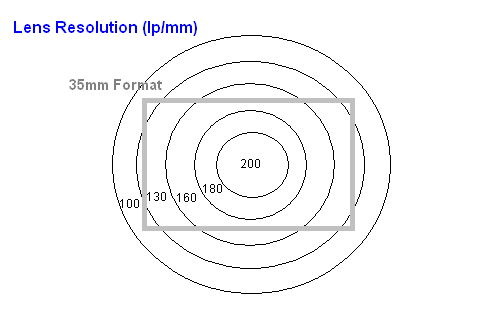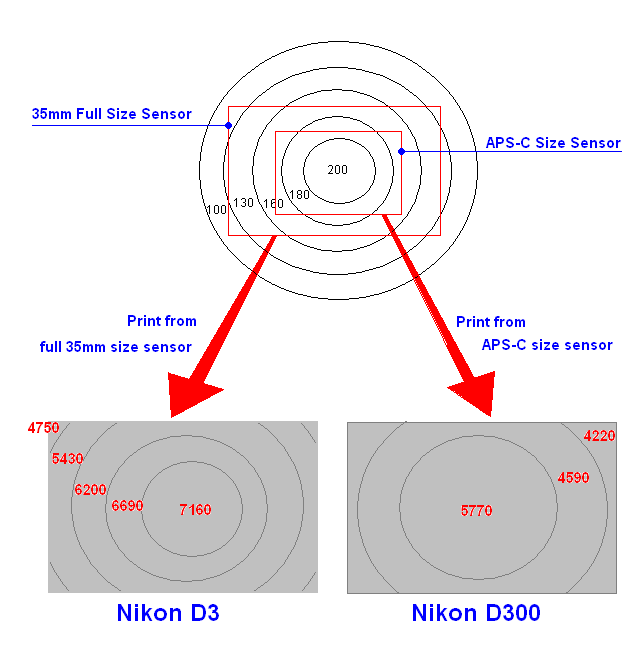Resolution Consideration
Based On Sensor Size:
Full 35mm Format vs. APS-C
Format
Back to Notes on Photography
by Makoto Honda
January 31, 2008
Nikon D3 vs. Nikon D300
--- FX vs. DX Format ---
Sony just announced a flagship Alpha DSLR, their full 35mm CMOS sensor model with effective 24.6 Mega pixels. This exceeds Canon EOS-1Ds Mark III having 21.1 Mega pixels. Digital cameras' megapixel war does not show any sign of letup.... only the battle is shifting toward the 35mm full-size arena. Several years ago when the sensors' pixel count was in their early pre-teens, sensors were the bottleneck in the final picture resolution. Now the sensor resolution starting from 10 mega for most DSLRs and some reaching or exceeding 20 mega pixels, the table is turned. The lens quality is getting increasingly more important to get the full advantage of these high resolution sensors.
The importance of lens resolution directly translates to the importance of the sensor size. Because the small er the sensor, the more strain it puts on the lens resolution. In other words, if the sensor size is greater, the lens has easier time forming a comparable image on it.
Let us compare two cameras having the same sensor count, but with different sensor sizes. Given the same lens resolution, the greater the sensor size, the better the final picture resolution. There is no room for argument on this theoretical prediction. This naturally gives an indisputable advantage to the larger sensor size. On the other hand, the small er sensor, by virtue of being small er, uses only the center portion of the image formed by the lens, so called a "sweet" spot. This gives the small er sensor a practical advantage.
How does a full 35mm full-size sensor compare with a small er APS-C format sensor in terms of the final picture resolution in a real-world situation? In this comparison, it is ideal to compare two cameras having the same mega pixel count. Since Nikon D3 (full 35mm format) and Nikon D300 (APS-C format) both have a 12 MP sensor, let us use these two DSLR cameras for our theoretical consideration.
It goes without saying the final picture resolution is affected by both lens and film. In digital photography, the sensor is the film. Here, we are using the following lens for comparison. The resolution of the lens is shown below. This is a fictitious lens resolution chart, but is ,nonetheless, reasonably realistic for a modern SLR camera lens having a full 35mm format image circle. The numbers in the figure are lens resolutions in lp/mm (line pairs per millimeter) at a given aperture.

We are going to see what kind of pictures we get from these cameras.
Using this lens on both Nikon D3 (FX format) and Nikon D300 (DX format), the illustration below shows which portion of the image formed by the lens is used for each format. Two prints (grey color), one from each camera, are compared side by side in terms of their resolution. The numbers (in red) are the estimated total dot counts for the entire picture area should the same sharpness extend over the entire frame. These numbers are a measure of sharpness of the final picture.

The result of this theoretical consideration demonstrates several general tendencies:
1) Full 35mm format offers a better resolution, as expected, for the picture center. Since the lens must cover the larger image circle, various lens flaws (aberrations) become noticeable toward the edges. Still, the resolution advantage of the full 35mm is obvious.
2) APS-C format is expected to provide more even resolution throughout the entire frame since it is only using the "sweet spot" of the lens.
3) If you average out the entire frame area in terms of the respective local resolution, the two formats come pretty close. If the lens performs well all the way to the corner, the large format advantage becomes more obvious. On the other hand, if the lens resolution falls drastically as you move away from the lens center, the small er APS-C format may give you an appreciable edge.
4) This comparison is done at 12 megapixels. Some people may consider the result "almost" tossup between Nikon D3 and Nikon D300. That is the very reason that Nikon has maintained the DX-format (APS-C) on their D2 series cameras up until last year (Nikon D2X). As the megapixel count increases to 16MP, 20MP, 24MP and beyond, the advantage of the larger format becomes more pronounced, and the small er APS-C format cannot compete effectively.
| Carnivorous Plants Photography Web Site: Copyright © 2001-2018 Makoto Honda. All Rights Reserved. |